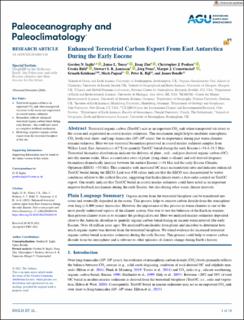| dc.contributor.author | Inglis, Gordon N. | |
| dc.contributor.author | Toney, Jaime L. | |
| dc.contributor.author | Zhu, Jiang | |
| dc.contributor.author | Poulsen, Christopher J. | |
| dc.contributor.author | Röhl, Ursula | |
| dc.contributor.author | Jamieson, Stewart S. R. | |
| dc.contributor.author | Pross, Jörg | |
| dc.contributor.author | Cramwinckel, Margot J. | |
| dc.contributor.author | Srinath, Krishnan | |
| dc.contributor.author | Pagani, Mark | |
| dc.contributor.author | Bijl, Peter K. | |
| dc.contributor.author | Bendle, James | |
| dc.date.accessioned | 2022-06-10T09:11:22Z | |
| dc.date.available | 2022-06-10T09:11:22Z | |
| dc.date.created | 2022-04-26T13:53:54Z | |
| dc.date.issued | 2022 | |
| dc.identifier.citation | Paleoceanography and Paleoclimatology. 2022, 37 (2), . | en_US |
| dc.identifier.issn | 2572-4517 | |
| dc.identifier.uri | https://hdl.handle.net/11250/2998284 | |
| dc.description.abstract | Terrestrial organic carbon (TerrOC) acts as an important CO2 sink when transported via rivers to the ocean and sequestered in coastal marine sediments. This mechanism might help to modulate atmospheric CO2 levels over short- and long- timescales (103–106 years), but its importance during past warm climates remains unknown. Here we use terrestrial biomarkers preserved in coastal marine sediment samples from Wilkes Land, East Antarctica (∼67°S) to quantify TerrOC burial during the early Eocene (∼54.4–51.5 Ma). Terrestrial biomarker distributions indicate the delivery of plant-, soil-, and peat-derived organic carbon (OC) into the marine realm. Mass accumulation rates of plant- (long-chain n-alkane) and soil-derived (hopane) biomarkers dramatically increase between the earliest Eocene (∼54 Ma) and the early Eocene Climatic Optimum (EECO; ∼53 Ma). This coincides with increased OC mass accumulation rates and indicates enhanced TerrOC burial during the EECO. Leaf wax δ2H values indicate that the EECO was characterized by wetter conditions relative to the earliest Eocene, suggesting that hydroclimate exerts a first-order control on TerrOC export. Our results indicate that TerrOC burial in coastal marine sediments could have acted as an important negative feedback mechanism during the early Eocene, but also during other warm climate intervals. | en_US |
| dc.language.iso | eng | en_US |
| dc.publisher | AGU | en_US |
| dc.rights | Navngivelse 4.0 Internasjonal | * |
| dc.rights.uri | http://creativecommons.org/licenses/by/4.0/deed.no | * |
| dc.title | Enhanced Terrestrial Carbon Export From East Antarctica During the Early Eocene | en_US |
| dc.title.alternative | Enhanced Terrestrial Carbon Export From East Antarctica During the Early Eocene | en_US |
| dc.type | Journal article | en_US |
| dc.type | Peer reviewed | en_US |
| dc.description.version | publishedVersion | en_US |
| dc.source.pagenumber | 0 | en_US |
| dc.source.volume | 37 | en_US |
| dc.source.journal | Paleoceanography and Paleoclimatology | en_US |
| dc.source.issue | 2 | en_US |
| dc.identifier.doi | 10.1029/2021PA004348 | |
| dc.identifier.cristin | 2019202 | |
| cristin.ispublished | true | |
| cristin.fulltext | original | |
| cristin.qualitycode | 1 | |

